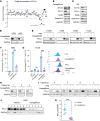Canagliflozin primes antitumor immunity by triggering PD-L1 degradation in endocytic recycling
- PMID: 36594471
- PMCID: PMC9797339
- DOI: 10.1172/JCI154754
Canagliflozin primes antitumor immunity by triggering PD-L1 degradation in endocytic recycling
Abstract
Understanding the regulatory mechanisms of PD-L1 expression in tumors provides key clues for improving immune checkpoint blockade efficacy or developing novel oncoimmunotherapy. Here, we showed that the FDA-approved sodium-glucose cotransporter-2 (SGLT2) inhibitor canagliflozin dramatically suppressed PD-L1 expression and enhanced T cell-mediated cytotoxicity. Mechanistic study revealed that SGLT2 colocalized with PD-L1 at the plasma membrane and recycling endosomes and thereby prevented PD-L1 from proteasome-mediated degradation. Canagliflozin disturbed the physical interaction between SGLT2 and PD-L1 and subsequently allowed the recognition of PD-L1 by Cullin3SPOP E3 ligase, which triggered the ubiquitination and proteasome-mediated degradation of PD-L1. In mouse models and humanized immune-transformation models, either canagliflozin treatment or SGLT2 silencing significantly reduced PD-L1 expression and limited tumor progression - to a level equal to the PD-1 mAb - which was correlated with an increase in the activity of antitumor cytotoxic T cells. Notably, prolonged progression-free survival and overall survival curves were observed in the group of PD-1 mAb-treated patients with non-small cell lung cancer with high expression of SGLT2. Therefore, our study identifies a regulator of cell surface PD-L1, provides a ready-to-use small-molecule drug for PD-L1 degradation, and highlights a potential therapeutic target to overcome immune evasion by tumor cells.
Keywords: Cancer immunotherapy; Immunology.
Figures








Comment in
-
How Sweet It Is: A Perspective on the Potential Anti-Tumor Role for SGLT2 Inhibitors.Kidney360. 2023 Sep 1;4(9):e1322-e1324. doi: 10.34067/KID.0000000000000219. Kidney360. 2023. PMID: 37487034 Free PMC article. No abstract available.
References
-
- Sen T, et al. Targeting DNA damage response promotes antitumor immunity through STING-mediated T-cell activation in small cell lung cancer. Cancer Discov. 2019;9(5):646–661. doi: 10.1158/2159-8290.CD-18-1020. - DOI - PMC - PubMed
Publication types
MeSH terms
Substances
LinkOut - more resources
Full Text Sources
Medical
Research Materials

